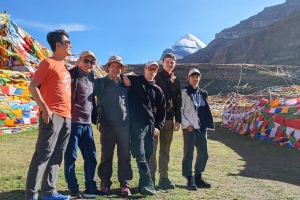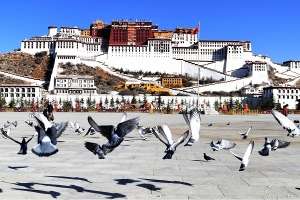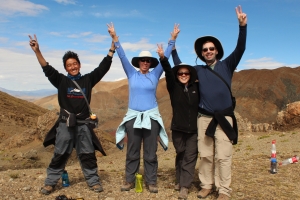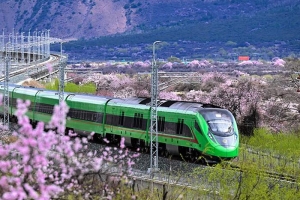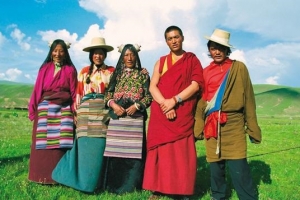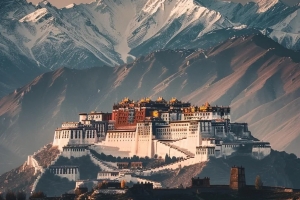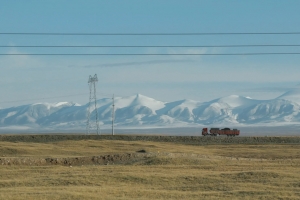Where Earth Meets Sky
The Qinghai–Tibet Railway is a marvel not merely of engineering, but of human perseverance and imagination. Linking Xining with Lhasa, it traces a path across some of the planet’s most forbidding and beautiful landscapes, where the air thins, the land stretches empty to every horizon, and the sky feels almost close enough to touch.
Covering roughly 1,956 kilometres, this iron thread binds lowland China with the sacred heart of Tibet, crossing frozen ground, scaling mountain passes, and bringing to life a journey that once took months by caravan. With oxygen-enriched carriages, broad observation windows, and reinforced tracks designed to float upon permafrost, the railway offers not only a means of travel, but a slow, steady acclimatisation to the otherworldly realm awaiting the traveller.
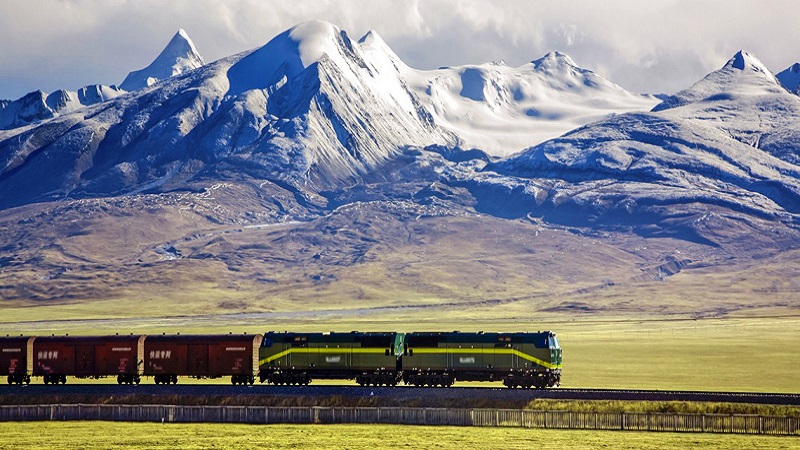
Qinghai-Tibet Railway
It is, quite simply, the most extraordinary train journey in the world.
Opening the Gate to the Plateau
Paper Shields and Sacred Keys
Before setting foot in Tibet, one must secure the necessary documents. Foreign travellers must not only hold a valid Chinese visa but must also obtain a Tibet Travel Permit, arranged exclusively through licensed travel agencies within China. Independent travel is, regrettably, forbidden — though in truth, the requirements often enrich the experience, ensuring guidance through a land where tradition and politics weave an intricate tapestry.
Further permits may be needed should one wish to venture beyond Lhasa, to places like Everest Base Camp or the far western shores of Mount Kailash.
Early preparation is wise; authorities are not known for their haste, and paperwork, much like altitude sickness, waits for no one.
Breathing Thin Air
At such punishing altitudes, one’s body is a fragile guest. Even those blessed with good health may fall prey to acute mountain sickness (AMS). Travelling by train offers a slower ascent than flying, giving the body precious hours to adapt. Nevertheless, a visit to a physician, a supply of AMS medication (such as acetazolamide), and a willingness to rest upon arrival are all prudent measures.
Hydration is vital. Alcohol is unwise. Pride is dangerous. Altitude spares neither the mighty nor the meek.
The Train That Climbs the Clouds
Comforts on the Edge of the World
The train offers several classes of travel. Soft sleeper compartments, featuring four berths and a door for privacy, offer comfort and warmth against the creeping cold. Hard sleepers and hard seats are economical options, but, for a journey of over 20 hours, many will find the modest luxury of a soft sleeper a wise investment.
For westbound travellers, the left-hand side of the train offers the most arresting vistas: endless grasslands, wild lakes of impossible blue, and the ghostly shapes of distant antelope.
Landmarks Along the Way
No artist could capture the scenes that drift past the carriage windows:
-
Qinghai Lake, vast and trembling under the open sky.
-
Kekexili Nature Reserve, barren and glorious, inhabited by creatures clinging to survival.
-
Tanggula Pass, where the train, defiant, breathes the rarefied air at over 5,000 metres.
-
Lhasa River, twining through green valleys as the highlands descend into the Holy City.
Announcements — in Mandarin, Tibetan, and English — hint at the wonders beyond the glass, but the true language of the journey is silence and wonder.
First Breath in Lhasa
Emerging into the high, thin air of Lhasa, the traveller finds the world curiously sharpened: colours brighter, sounds crisper, shadows deeper.
The station itself is spacious and orderly, sitting modestly outside the city’s ancient heart. Taxis and tour guides await, though many visitors wisely choose to move slowly, letting their bodies absorb the reality of a city perched at 3,650 metres.
Patience is not a luxury here. It is a necessity.
Experiences in Tibet
Lhasa: The Spirit of the Mountain Kingdom
Potala Palace rises like a mirage of white and ochre, its thousand windows catching the sun like facets of a jewel. Inside, a warren of chapels, corridors, and secret staircases speaks of centuries of prayer, politics, and exile.
Close by, Jokhang Temple pulses with life — an ancient heart still beating in the modern world. Pilgrims spin prayer wheels, prostrate themselves upon the stones, and murmur ancient mantras, while the circular Barkhor Street hums with the commerce of faith and curiosity.
Here, belief is not an abstraction but the living air.
Beyond the City Walls: Secrets of the Plateau
For those willing to journey beyond Lhasa, the rewards are immense:
-
Yamdrok Lake, turquoise and trembling beneath a blinding sky.
-
Gyantse and Shigatse, home to towering monasteries and timeless rituals.
-
Mount Everest Base Camp, where the mountain known as Qomolangma — the Holy Mother — stands in cold, remote majesty.
Each journey demands a respectful pace. Altitude punishes haste.
A Note on Reverence
Tibet is not a museum piece, nor a theatre for the curious. It is a living culture, proud, wounded, sacred. One should behave as a guest, not a conqueror. Photography inside temples is often forbidden, and the faces of monks and villagers are not trophies for the traveller’s lens.
Respect opens doors that arrogance slams shut.
Essentials for the Journey
-
Currency: The Chinese yuan (RMB) rules here. Cash is king once beyond the city walls.
-
Climate: Sunburn and frostbite are not mutually exclusive. Bring layers, sunscreen, and the best sunglasses you can afford.
-
Connectivity: The internet is unreliable and censored. A VPN is advisable for those wishing to access the outside world.
-
Sustenance: Tibetan fare — hearty, simple, and heavy with barley and yak — may challenge delicate palates. Adventurous souls will be rewarded; cautious eaters will find solace in noodle soups and rice dishes.
Final Musings
To ride the Qinghai–Tibet Railway, to stand beneath the banners of prayer at 5,000 metres, to feel one’s breath taken not by exertion but by wonder — this is no ordinary holiday.
It is a rite of passage, a small and trembling encounter with something vast and eternal. The Plateau does not yield its secrets easily, nor does it trouble itself to explain its majesty. It simply is, immense and patient, awaiting those willing to tread lightly upon its sacred soil.
Leave your certainties behind. Bring your reverence. In return, Tibet will gift you memories that will not fade with the passing of seasons.



